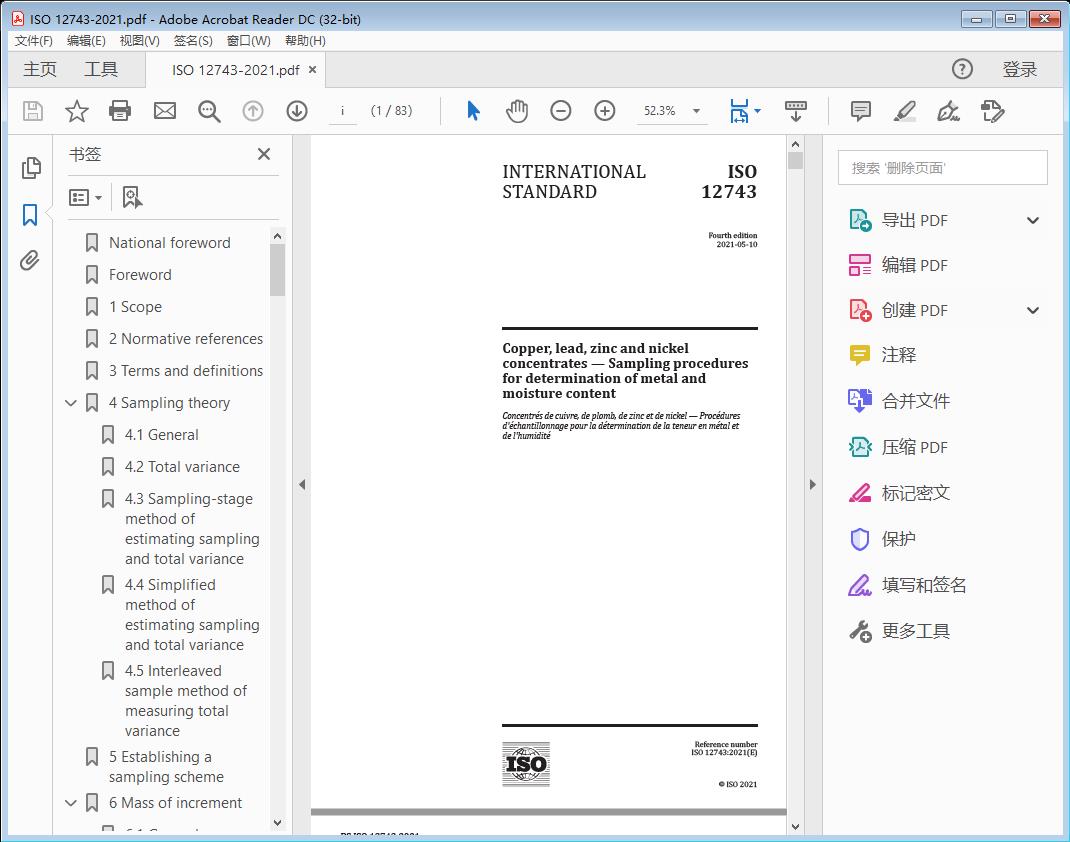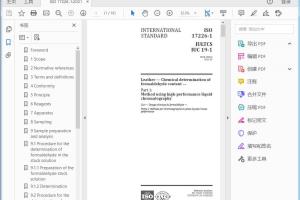ISO 12743:2021 Copper, lead, zinc and nickel concentrates — Sampling procedures for determination of metal and moisture content
标准简介
Copper, lead, zinc and nickel concentrates — Sampling procedures for determination of metal and moisture content是于2021-05-10发布的ISO标准,适用于全球。标准截图

标准文档说明
标准文档类型为Copper, lead, zinc and nickel concentrates — Sampling procedures for determination of metal and moisture content高清PDF版本(文字版),标准文档内可进行搜索,可以复制原文,可粘贴。标准部分原文
INTERNATIONAL STANDARD ISO 12743:2021
Copper, lead, zinc and nickel concentrates — Sampling procedures for determination of metal and moisture content
WARNING — This document can involve hazardous materials, operations and equipment. It is the responsibility of the user of this document to establish appropriate health and safety practices and to ensure compliance with any other restrictions.
1 Scope
This document sets out the basic methods for sampling copper, lead, zinc and nickel concentrates from moving streams and stationary lots, including stopped-belt sampling, to provide samples for chemical analysis, physical testing and determination of moisture content, in accordance with the relevant International Standards. Where the concentrates are susceptible to significant oxidation or decomposition, a common sample that is sufficiently representative, i.e. unbiased and sufficiently precise, is used for moisture determination and chemical analysis to eliminate bias (see ISO 10251). Any large agglomerates (>10 mm) present in the primary sample are crushed prior to further sample processing. Sampling of concentrates in slurry form is specifically excluded from this document.
Stopped-belt sampling is the reference method for collecting concentrate samples against which mechanical and manual-sampling procedures can be compared. Sampling from moving streams is the preferred method. Both falling-stream and cross-belt samplers are described.
Sampling from stationary lots is used only where sampling from moving streams is not possible. The procedures described in this document for sampling from stationary lots only minimize some of the systematic sampling errors.
2 Normative references
The following documents are referred to in the text in such a way that some or all of their content constitutes requirements of this document. For dated references, only the edition cited applies. For undated references, the latest edition of the referenced document (including any amendments) applies.
ISO 10251, Copper, lead, zinc and nickel concentrates — Determination of mass loss of bulk material on drying
ISO 12744, Copper, lead, zinc and nickel concentrates — Experimental methods for checking the precision of sampling
ISO 13292, Copper, lead, zinc and nickel concentrates — Experimental methods for checking the bias of sampling
3 Terms a nd definiti ons
For the purposes of this document, the following terms and definitions apply.
ISO and IEC maintain terminological databases for use in standardization at the following addresses:
— ISO Online browsing platform: available at https://www.iso.org/obp
— IEC Electropedia: available at http://www.electropedia.org/
ISO 12743:2021
3.1
representative sample
quantity of concentrate representing a larger mass of concentrate with both precision (3.29) and bias (3.28) within acceptable limits
3.2
lot
quantity of concentrate to be sampled
3.3
lot sample
quantity of concentrate representative of the lot (3.2)
3.4
sub-lot
subdivided parts of a lot (3.2) which are processed separately, each of them producing a subsample (3.5) which is analysed separately, for example for moisture determination
3.5
subsample
quantity of concentrate representative of the sub-lot (3.4)
3.6
sampling
sequence of operations aimed at obtaining a sample representative of a lot (3.2)
Note 1 to entry: It comprises a series of sampling stages, each stage usually comprising operations of selection and preparation.
3.7
selection
operation by which a smaller quantity of concentrate is taken from a larger quantity of concentrate
3.8
increment
quantity of concentrate selected by a sampling device in one operation
3.9
division
operation of decreasing sample mass, without change of particle size, where a representative part of the sample is retained
3.10
constant-mass division
method of division (3.9) in which the retained portions from individual increments (3.8) or subsamples (3.5) are of uniform mass
3.11
proportional division
method of division (3.9) in which the retained portions from individual increments (3.8) or subsamples (3.5) are a constant proportion of their original mass
3.12
preparation
nonselective operation without division (3.9) such as sample transfer, drying, comminution or homogenization
3.13
sample processing
whole sequence of selection and preparation operations which transforms a stage i sample (3.15) into a test sample (3.19)
网盘链接
百度网盘:https://pan.baidu.com/s/1iEIUqO5goLbSTbKyQlKPPg
提取码:pqwj
【温馨提示】大资料ISO是提供信息发布的专业信息类网站,所有内容均由用户发布,不代表本站观点,本站亦不存储所涉及的文件及资料。如有【免费资料】以及【付费资料】,请用户根据自己的需求,自行判断是否需要获取。如有交易诈骗、内容侵权可发送邮件至kf@dzl100.com,我们审查后若发现情况属实,会立即对相关内容进行删除处理。
加载用时:112.2631 毫秒
相关评论
相关文章
-

ISO 12743:2021 Copper, lead, zinc and nickel concentrates — Sampling procedures for determination of metal and moisture content
Copper, lead, zinc and nickel concentrates — Sampling procedures for determination of metal and moisture content是国际标准化组织于2021-05-10发布的ISO标准,适用于全球。本次分享的标准文档为高清PDF(文字版),标准文档内可搜索,可复制,可粘贴。本文结尾附网盘链接。
-

ISO 10014:2021 Quality management systems — Managing an organization for quality results — Guidance for realizing financial and economic benefits
Quality management systems — Managing an organization for quality results — Guidance for realizing financial and economic benefits是国际标准化组织(International Organization for Standardization,简称ISO)于2021-04-20发布的ISO标准,适用于世界范围。本次分享的标准文档为高清PDF(文字版),标准文档内可搜索,可复制,可粘贴。本文结尾附网盘链接。
-

ISO 19475:2021 Document management — Minimum requirements for the storage of documents
Document management — Minimum requirements for the storage of documents是国际标准化组织(International Organization for Standardization,简称ISO)于2021‑06‑10发布的ISO标准,适用于全球。本次分享的标准文档为高清PDF(文字版),标准文档内可搜索,可复制,可粘贴。本文结尾附网盘链接。
-

ISO 19206-3:2021 Road vehicles — Test devices for target vehicles, vulnerable road users and other objects, for assessment of active safety functions —Part 3: Requirements for passenger vehicle 3D targets
Road vehicles — Test devices for target vehicles, vulnerable road users and other objects, for assessment of active safety functions —Part 3: Requirements for passenger vehicle 3D targets是ISO于2021‑05‑21发布的ISO标准,适用于全球范围。本次分享的标准文档为高清PDF(文字版),标准文档内可搜索,可复制,可粘贴。本文结尾附网盘链接。
-

ISO 16355-1:2021 Application of statistical and related methods to new technology and product development process —Part 1: General principles and perspectives of quality function deployment (QFD)
Application of statistical and related methods to new technology and product development process —Part 1: General principles and perspectives of quality function deployment (QFD)是ISO于2021-05发布的ISO标准,适用于世界范围。本次分享的标准文档为高清PDF(文字版),标准文档内可搜索,可复制,可粘贴。本文结尾附网盘链接。
-

Petroleum and natural gas industries — Site-specific assessment of mobile offshore units —Part 3: Floating units
Petroleum and natural gas industries — Site-specific assessment of mobile offshore units —Part 3: Floating units是国际标准化组织(International Organization for Standardization,简称ISO)于2021-03发布的ISO标准,适用于国际,世界范围。本次分享的标准文档为高清PDF(文字版),标准文档内可搜索,可复制,可粘贴。本文结尾附网盘链接。
-

ISO 17226-1:2021 INTERNATIONAL STANDARDIULTCS/IUC 19-1:2021(E)Leather — Chemical determination of formaldehyde content —Part 1: Method using high-performance liquid chromatography
INTERNATIONAL STANDARDIULTCS/IUC 19-1:2021(E)Leather — Chemical determination of formaldehyde content —Part 1: Method using high-performance liquid chromatography是国际标准化组织于2021-02发布的ISO标准,适用于国际范围。本次分享的标准文档为高清PDF(文字版),标准文档内可搜索,可复制,可粘贴。本文结尾附网盘链接。
-

ISO 16140-3:2021 Microbiology of the food chain — Method validation —Part 3: Protocol for the verification of reference methods and validated alternative methods in a single laboratory
Microbiology of the food chain — Method validation —Part 3: Protocol for the verification of reference methods and validated alternative methods in a single laboratory是国际标准化组织于2021-01发布的ISO标准,适用于全球。本次分享的标准文档为高清PDF(文字版),标准文档内可搜索,可复制,可粘贴。本文结尾附网盘链接。
-

ISO 16321-1:2021 Eye and face protection for occupational use —Part 1: General requirements
Eye and face protection for occupational use —Part 1: General requirements是ISO于2021-03发布的ISO标准,适用于全球。本次分享的标准文档为高清PDF(文字版),标准文档内可搜索,可复制,可粘贴。本文结尾附网盘链接。
-

ISO 10140-1:2021 Acoustics — Laboratory measurement of sound insulation of building elements —Part 1: Application rules for specific products
Acoustics — Laboratory measurement of sound insulation of building elements —Part 1: Application rules for specific products是国际标准化组织(International Organization for Standardization,简称ISO)于2021-05发布的ISO标准,适用于世界范围。本次分享的标准文档为高清PDF(文字版),标准文档内可搜索,可复制,可粘贴。本文结尾附网盘链接。
-

ISO 11665-4:2021 Measurement of radioactivity in the environment — Air: radon-222 —Part 4: Integrated measurement method for determining average activity concentration using passive sampling and delayed analysis
Measurement of radioactivity in the environment — Air: radon-222 —Part 4: Integrated measurement method for determining average activity concentration using passive sampling and delayed analysis是国际标准化组织于2021-03发布的ISO标准,适用于全球。本次分享的标准文档为高清PDF(文字版),标准文档内可搜索,可复制,可粘贴。本文结尾附网盘链接。
-

ISO 14644-17:2021 Cleanrooms and associated controlled environments —Part 17: Particle deposition rate applications
Cleanrooms and associated controlled environments —Part 17: Particle deposition rate applications是国际标准化组织于2021-02发布的ISO标准,适用于全球范围。本次分享的标准文档为高清PDF(文字版),标准文档内可搜索,可复制,可粘贴。本文结尾附网盘链接。
-

ISO 10315:2021 Cigarettes — Determination of nicotine in total particulate matter from the mainstream smoke — Gas-chromatographic method
Cigarettes — Determination of nicotine in total particulate matter from the mainstream smoke — Gas-chromatographic methodWARNING — The use of this document can involve hazardous materials, operations and equipment. This document does not purport to address all the safety problems associated with its use. It is the responsibility of the user of this document to establish appropriate safety and health practices and determine the applicability of any other restrictions prior to use.是国际标准化组织(Interna
-

ISO 19290:2021 Cigarettes — Determination of tobacco specific nitrosamines in mainstream cigarette smoke — Method using LC-MS/MS
Cigarettes — Determination of tobacco specific nitrosamines in mainstream cigarette smoke — Method using LC-MS/MS是国际标准化组织于2021-02发布的ISO标准,适用于国际范围。本次分享的标准文档为高清PDF(文字版),标准文档内可搜索,可复制,可粘贴。本文结尾附网盘链接。
-

ISO 10140-4:2021 Acoustics — Laboratory measurement of sound insulation of building elements —Part 4: Measurement procedures and requirements
Acoustics — Laboratory measurement of sound insulation of building elements —Part 4: Measurement procedures and requirements是ISO于2021-04发布的ISO标准,适用于全球范围。本次分享的标准文档为高清PDF(文字版),标准文档内可搜索,可复制,可粘贴。本文结尾附网盘链接。